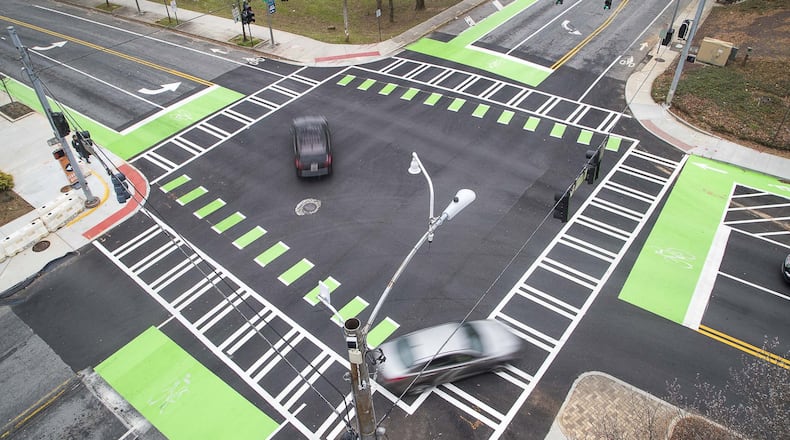Bryan Simmons has a love-hate relationship with the bike lanes in Decatur.
A Decatur resident since 2002, he is an active cyclist who rides for physical fitness. But when he drives his car through downtown Decatur, the city’s new bike lanes have made his commute horrible, he said.
Like many, Simmons has recently wondered if city leaders have created a new problem by trying to fix an old one.
“Is it progress that I can’t reasonably drive through my own community?” Simmons said. “In order to make space for the new, deluxe bike lanes, my street has been mangled and choked to the point where it’s too much trouble to try going anywhere in one direction most days.”
More than three years into its effort to separate bikes from cars on streets, widen sidewalks and reduce lanes for car traffic, Decatur faces a reckoning. Among communities in metro Atlanta, it’s one of the most aggressive pushers of bike lanes. But many residents say it’s made traffic congestion noticeably worse.
The issue could come to a head in the coming weeks as Decatur holds citizen roundtables to formulate its 2030 strategic plan — and weigh whether to expand the bike-friendly drive or hit the brakes.
Many more towns will soon face the same dilemma, including Atlanta, Dunwoody and Sandy Springs, as they put in their own bike paths, wider sidewalks and improved crosswalk markings. Will residents accept the hassle in exchange for better safety for cyclists and pedestrians, as well as perceived improvements to livability?
Decatur Mayor Patti Garrett, who is pro-bike, said her city is trying to influence a shift in attitudes, which may take some time.
“Hopefully as the children and youth grow up, they will be accustomed to hopping on something other than always in a car,” she said.
Decatur's bike lanes emerged from its last strategic plan, promoted heavily by former city councilman Fred Boykin (whose shop, Bicycle South, closed in July 2019). The city officially adopted the PATH Foundation's connectivity plan in 2016, designed to connect its city streets to PATH's existing network of 600 miles of multiuse paths and protected bike lanes.
The city is adding or has added marked bike lanes and paths, wider sidewalks and other streetscape improvements, like better-marked crosswalks, to major arteries Church Street, Commerce Drive and McDonough Street. It also has removed some car lanes.
The "road diet," estimated to cost $20 million to $25 million, also includes traffic-calming features like raised intersections and speed tables and reconfiguring traffic flow by replacing some directional automobile lanes with turning lanes. Decatur recently painted the bike paths bright green, in both solid and dashed patterns, to indicate traffic rules for bikes, pedestrians and cars.
Decatur expects to finalize its strategic plan this fall and combine it with its state-mandated comprehensive plan. Georgia cities must approve 10-year comprehensive plans to qualify for certain financial programs from the Georgia Department of Community Affairs, said Davia Rose Lassiter, an agency spokeswoman. The plans reflect a city’s policy goals but don’t themselves carry legal weight.
It’s still very much a work in progress.
“There’s always a sense of bike-lash,” said Tonio Andrade, co-founder of the Decatur Bicycle Coalition. “People are complaining a lot about increased traffic and they’re blaming bike lanes for this.”
Resident Charles McKinney said city planners made numerous mistakes in reconfiguring streets for car traffic — and that he regularly sees bike groups ignore traffic rules.
“Packs of bike riders routinely run red lights and don’t slow or stop at posted intersections,” McKinney said.
Decatur resident Ed Jacobson observed that while the city is trying to discourage car usage, it has also approved new multifamily residential developments that come with multistory parking decks. A mixed-use development called 120 West Trinity that is under construction includes a large parking deck. Its location already sees 12,300 cars per day, according to real estate data provider LoopNet.
“The additional apartments and condos in the central business district will probably generate more automobile traffic than we now experience,” Jacobson said.
Melissa McNamara, a spokeswoman for Atlanta-based Cousins Properties, one of the developers of 120 West Trinity, declined to comment.
Population growth has also likely played a role in traffic congestion. The city of Decatur’s population rose 31% to 25,732 from 2010 to 2018, according to the U.S. Census Bureau.
City officials did not formally study the impact that the new bike lanes would have on traffic in the downtown district, said Hugh Saxon, deputy city manager. But a 2016 report found that traffic volumes rose 23% along portions of Commerce Drive, and 20% on East Ponce de Leon Avenue, two major streets, between 2011 and 2015.
The city hopes the new lanes will eventually encourage more people to replace their car trips with bike rides, possibly alleviating traffic in the long run. Another primary goal is to make the streets safer for pedestrians.
Pedestrian safety has become a pressing issue nationwide, after 7,140 pedestrians and cyclists were killed in the U.S. in traffic crashes in 2018, the highest level since 1990, according to the National Highway Traffic Safety Administration.
In Decatur, some of the intersections set to receive bike lanes saw the highest number of accidents involving vehicles, bikes and pedestrians that resulted in injuries.
Three intersections on Commerce Drive were identified as some of the most dangerous in the city, according to data from 2015 to 2017, the most-recent figures available. They saw a total of 45 accidents with injuries over the three-year period.
“To the extent we can slow traffic down, I think we are providing a safer environment,” Saxon said.
Many other local communities have the same goal. Atlanta Mayor Keisha Lance Bottoms last year announced a $5 million plan to triple the city's network of protected bike lanes. But a pop-up bike lane installed in Midtown last month, part of the mayor's program, was criticized for causing traffic problems.
Sandy Springs wants to use federal funding to cover most of the cost of a north-south extension of PATH trails to the Perimeter, where it could connect with its own bike paths and those planned in Dunwoody. Nearby Roswell has an active program to encourage bikes for physical fitness and recreation.
Peachtree City has more than 100 miles of multiuse trails, many of which were built as part of the city’s original plan. Unlike Decatur, however, most of Peachtree City’s bike paths are physically separated from auto traffic and don’t run through the center of town.
Outside Georgia, bicycle commuting has become a routine part of life. In Portland, Ore., commuter railroad trains include hooks to hang bicycles. The city of Davis, Calif., has more bikes per capita than any city in the U.S., and bike-parking corrals are spread across town, according to Mobility Lab.
About 1,500 city or counties nationwide have adopted the Complete Streets standards for bike and pedestrian safety, typically seeing safety improvements soon afterward, according to Steve Davis, a spokesman for Smart Growth America.
“The point is increasing safety for people already walking and biking,” Davis said.
Bike lanes may inconvenience motorists in Decatur during the morning and evening rush hours, said Doug Eidle, who has lived in Decatur for 25 years. But they make too much sense otherwise, he said.
“It’s significantly slowed traffic and made everyone safer,” Eidle said.
Keep Reading
The Latest
Featured









